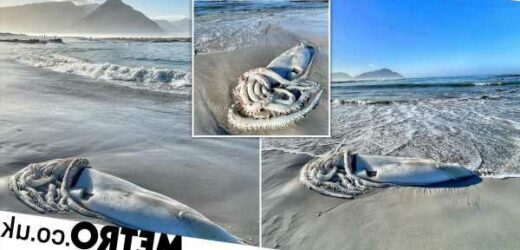The body of a giant squid has washed up on a beach in South Africa – leaving beachgoers stunned.
Giant squid are one of the most mysterious creatures in the ocean with sightings of them being extremely rare.
The deep-sea monsters had never been photographed alive until 2002 and were only caught on camera for the first time in 2006.
Thanks to their elusive nature, the creatures are surrounded by legend and are thought to have inspired stories of the Kraken – a mythical sea monster which is said to have preyed on ships.
Giant squid are capable of growing up to 43 feet long and may weigh up to a tonne but because they are so elusive, most of what scientists know about them has been learned from the carcasses of dead squid washed up on beaches.
So, when the corpse of one appeared on the shoreline in Kommetjie, near Cape Town at the weekend, it quickly became a local spectacle.
Ali Paulus was one of those who rushed to the beach to take a look, taking her family with her.
The 44-year-old said after heading to the beach to see the squid she ‘couldn’t believe how big it was’, estimating the beast was around 11ft long.
‘My husband is 6ft 2ins and the squid’s mantle was longer – around 7ft 2ins – plus then the tentacles and arms,’ she said.
‘What really stood out to me were the razor sharp “teeth” inside the suckers on their tentacles.
‘I have since learnt that they are used to defend themselves against sperm whales.
‘I was super sad that the squid was dead, however, it was incredibly fascinating for my sons to see.
‘I have never seen anything like it before.’
Previous specimens of giant squid collected in South Africa are kept in the natural science history collection of Iziko Museums.
Melbourne Aquarium in Australia even paid A$100,000 (£57,400) for the intact remains of one giant squid in 2005, so scientists could study the specimen.
However, by the time wildlife officers made it to the carcass found in Kommetjie, its body had already been carved up for souvenirs and meat.
Now, Ali’s photos of the beast may be the best record of it.
‘Sadly some fishermen from a local community removed some parts for eating,’ she said.
Giant squid – mysterious monsters of the deep
Very little is known about giant squid because they live in some of the most inhospitable and deepest parts of the ocean.
Giant squid are the largest invertebrates on the planet and have been found in all of the world’s oceans.
They have eight legs and two long feeding tentacles which they use to catch prey.
The largest specimen ever recorded was 59ft long and weighed nearly a tonne. The creatures move through the ocean by sucking water in through their mantle before forcing it out through the back of their bodies.
Along with their cousin, the Colossal Squid, giant squid have the biggest eyes in the animal kingdom.
Their eyes can measure up to 10 inches in diameter and help them to catch prey in the depths of the ocean.
Giant squid survive on a diet of fish, shrimp and other smaller squids with some scientists suggesting they may also be partial to the occasional baby whale.
Source National Geographic
Jon Friedman, a wildlife officer from the Cape of Good Hope Society for the Prevention of Cruelty to Animals (SPCA), said there wasn’t much left to collect.
‘We were only able to salvage a few tissue samples for Iziko,’ he said.
‘The most important pieces of the animal that could have offered us insight into aspects of the animal’s age, its diet, and cause of death had already been removed by fishermen and trophy hunters.’
Ali said it looked like the squid had been hit by a ship’s propellor, a theory Jon supported.
‘As to her cause of death, I would say that she was most likely struck by a ship while she was at the sea surface,’ he said.
‘From the condition of its internal organs that were left behind, I would say that the animal seemed in good health, her stomach was full and she was only about two years old.’
Get in touch with our news team by emailing us at [email protected].
For more stories like this, check our news page.
Source: Read Full Article



